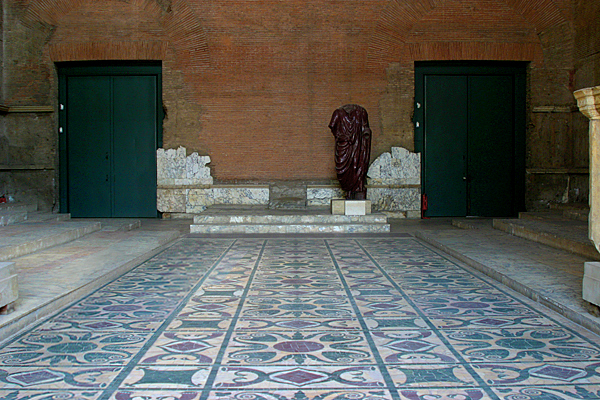
"And certainly, the senate house in particular should be built above all so as to enhance the dignity of the town or city. And if this senate house is going to be square, then whatever its length, its height should be half again as much. If, on the other hand, it is to be oblong, then the length and width should be added together, and half this measure should be given over to the height of the senate house up to the level of the ceiling coffers."
Vitruvius, De Architectura (V.2.1)
Begun by Julius Caesar to replace the old Curia Hostilia, which had burned (along with the body of Clodius Pulcher) in riots in 52 BC, the new Senate House was completed in 29 BC by Octavian who, two years later, would be given the title of Augustus (Augustus, Res Gestae, XIX; Dio, Roman History, LI.22.1). The Curia Julia may have been afflicted by the Neronian fire of AD 64, the fire of AD 69 on the Capitoline Hill, or a fire in AD 80 during the reign of Titus. Whatever damage was sustained, it was restored by Domitian in AD 94 and, after another disastrous fire in AD 283, completely rebuilt to the same dimensions by Diocletian.
The building was converted to a church in AD 630, which accounts for the preservation of its original porphyry and serpentine floor, the low broad steps that accommodated the senators' seats, and the three large windows. The great bronze doors were removed in the mid-seventeenth century to serve as the portals of the basilica of San Giovanni in Laterano (St. John Lateran). In 1938, to celebrate the two thousandth anniversary of the birth of Augustus, Rome's first emperor, Mussolini completed the restoration of the Curia, having removed the baroque church that surrounded it.

A coin issue of AD 28 shows the Senate House as having a chalcidicum or colonnaded porch raised on a high podium in front (one still can see in the photograph where it was fitted to sockets beneath the windows) with a statue of Victory crowning the pediment and two acroteria at the corners: figures holding a scepter or spear and extending a patera (libation bowl).
Aside from the altar and statue of Victory, Augustus placed in the Curia two paintings (Pliny, Natural History, XXXV.10). In 27 BC, a golden shield was put there as well in recognition of his valor, clemency, justice, and piety—the four imperial virtues (Augustus, Res Gestae, XXXIV).

Following the prescription of Vitruvius, the height of the Curia is half the sum of its length and width, the ratio which he deemed correct for proper acoustics.
The marble floor is a beautiful example of opus sectile, in which pieces of colored stone are fitted together in figured patterns or geometric shapes. Just visible on the steps to the sides in the photograph are two large marble reliefs (anaglyphs) or parapets (plutei) which were found in the Forum and may have decorated the Rostra as a balustrade. The porphyry statue in the background was found behind the Curia and is thought to belong to a monument honoring Trajan. The Senate floor now is used as a venue for temporary exhibits and no longer so bare.
References: Vitruvius: Ten Books on Architecture (2001) translated and edited by Ingrid D. Rowland and Thomas Noble Howe. The line drawing has been taken from Rome: An Oxford Archaeological Guide (1998) by Amanda Claridge.
See also Victoria.